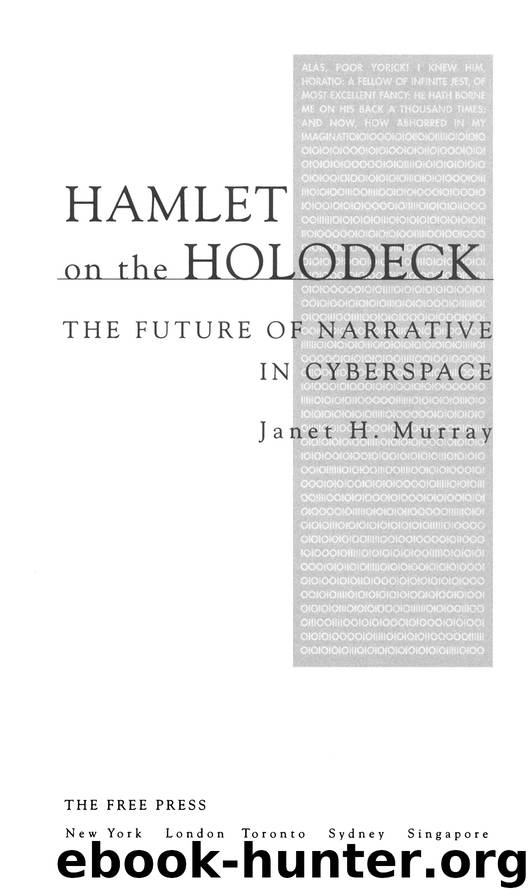Hamlet on the Holodeck by Janet H. Murray

Author:Janet H. Murray
Language: eng
Format: epub
Publisher: Free Press
Enactment as a Transformational Experience
As Scheherazade and Jesus both knew, storytelling can be a powerful agent of personal transformation. The right stories can open our hearts and change who we are. Digital narratives add another powerful element to this potential by offering us the opportunity to enact stories rather than to merely witness them.
Enacted events have a transformative power that exceeds both narrated and conventionally dramatized events because we assimilate them as personal experiences. The emotional impact of enactment within an immersive environment is so strong that virtual reality installations have been found to be effective for psychotherapy. Psychologists in several research centers are treating phobic patients by exposing them to virtual environments that simulate the situations that trigger their anxiety attacks. The desensitizing process is in essence a participation in a fictional world. Researchers in California and Atlanta have relieved patients’ long-standing fear of heights by having them “walk” over virtual bridges and ride in virtual elevators. Patients initially respond to the virtual environments with terror, just as they would to the real-world experience. The therapist then accompanies them through the experience, helping them practice self-calming behaviors. Essentially, the patients are practicing coping behaviors in the virtual environment; they are like actors at a dress rehearsal. The inner changes brought on by such experiential learning then allow them to apply the same behaviors to the real world. Patients who can ride a virtual glass elevator in a virtual hotel lobby can then go to dinner on the seventy-second floor of the Peachtree Plaza in Atlanta, and patients who cross a virtual Golden Gate Bridge can then cross the real one.11
This virtual reality therapy falls between two other therapeutic techniques: actually accompanying the patient in the real-life frightening situation and talking the patient through an imaginary experience under hypnosis. The virtual world is more external than the hypnotic experience but artificial enough to make it possible for patients to approach it at a much earlier stage than they could if facing the actual situation. It is a threshold environment. Those patients who do not find VR therapy helpful are those who complain that it is either too real or not real enough. The key to the success of the treatment, then, is the establishment of the world as a fictional space.
These results echo the processes observed in some MUD participants who use their imaginary personas to practice social skills they are trying to cultivate in the “real” (i.e., nonelectronic) world. For instance, one woman recovered her sexual confidence after an amputation by enacting the part of a similarly handicapped character on a MUD.12 As in the case of the phobic patients, the virtual experience worked because it was enough like the real one to raise the same anxieties but safe enough to allow for imaginative rehearsal.
The transformational power of enacted narratives holds both promise and danger for the future. On the one hand, it may make digital environments as important as television currently is for the presentation of problem plays, stories about social injustice or intolerance that are meant to broaden the audience’s sympathies.
Download
This site does not store any files on its server. We only index and link to content provided by other sites. Please contact the content providers to delete copyright contents if any and email us, we'll remove relevant links or contents immediately.
4 3 2 1: A Novel by Paul Auster(12286)
The handmaid's tale by Margaret Atwood(7679)
Giovanni's Room by James Baldwin(7192)
Asking the Right Questions: A Guide to Critical Thinking by M. Neil Browne & Stuart M. Keeley(5641)
Big Magic: Creative Living Beyond Fear by Elizabeth Gilbert(5614)
Ego Is the Enemy by Ryan Holiday(5294)
The Body: A Guide for Occupants by Bill Bryson(4974)
On Writing A Memoir of the Craft by Stephen King(4863)
Ken Follett - World without end by Ken Follett(4645)
Adulting by Kelly Williams Brown(4487)
Bluets by Maggie Nelson(4474)
Eat That Frog! by Brian Tracy(4436)
Guilty Pleasures by Laurell K Hamilton(4362)
The Poetry of Pablo Neruda by Pablo Neruda(4040)
Alive: The Story of the Andes Survivors by Piers Paul Read(3969)
White Noise - A Novel by Don DeLillo(3954)
Fingerprints of the Gods by Graham Hancock(3942)
The Book of Joy by Dalai Lama(3901)
The Bookshop by Penelope Fitzgerald(3777)
